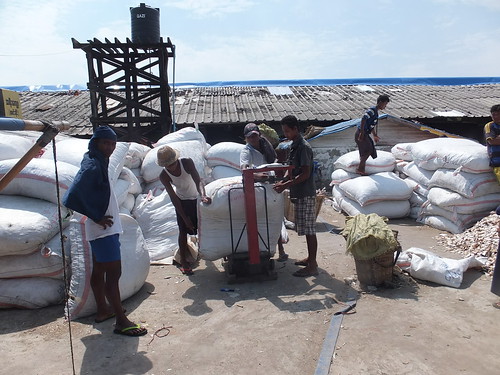 'Traditional' methods of cargo handling still in use on the quayside
'Traditional' methods of cargo handling still in use on the quayside in Sittwe, Myanmar.
Background
International shipping has always been important to trade but, within the last century, methods have been revolutionised by the introduction of standardised shipping containers ('containerisation') which replaced traditional cargo handling a piece at a time ('break-bulk cargo'). The enterprising North American haulier Malcolm McLean (1913-2001) accelerated this process in the 1950s. Effective designs by mechanical engineer Keith Tantlinger (1919-2011) allowed Freuhauf to build demountable shipping containers for McLean (Freuhauf invented the road trailer for motor trucks under the leadership of Augustus Freuhauf. The long and ultimately chequered history of Freuhauf is detailed by the Freuhauf Trailer Historical Society here).
McLean patented his designs, but gave a royalty-free license to the International Standards Organisation and the success of the innovation allowed goods to be efficiently moved around the world. There are Wikipedia articles about containerisation here and the containers used here. The most common containers are 20 feet or 40 feet long but shorter, longer and taller ('hi-cube') patterns are also used. Various special-purpose containers are provided either for carrying bulk liquids in tanks or products requiring refrigeration. The latter, called 'reefers', have built-in chilling equipment and loaded containers need external electric power to be connected whilst in storage or transit.
The success of the system was founded on the simplicity and reliability of the Twistlocks used in handling and securing containers - each container has eight Twistlock corner castings (4 on top, 4 underneath) which mate with either the handling crane, carrying vehicle (road trailer, rail vehicle or ship) or separate 'mid-locks' (allowing containers to be stacked). The need for manual labour was dramatically reduced and theft of cargo, whilst not eliminated, became a much more sophisticated crime. Road lorries could transport containers directly to or from the consignee or to a shipping agent who could ‘stuff’ or ‘strip’ part container loads. So, in docks all over the world, huge areas were concreted over to provide access for the container lorries and storage for the shipping containers coming and going.
The efficiency of container ships for intercontinental transport led to continuous increases in size of these vessels to reduce shipping costs. The size of ships that can pass through the major canals of the world (notably the Panama and Suez) sets the upper limit for ship dimensions. There's a clear explanation of the terms 'Panamax', 'Post-Panamax' and 'Panamax New' in Wikipedia here. A rough idea of the capacity of container ships is given by the 'TEU' - 'Twenty-foot equivalent unit', dscribed in Wikipedia here. Large container ships now have a capacity of 23,000 TEU.
Panama Canal
In 2008, I made a 'Partial Transit' of the Panama Canal, which is described here, with some additional information in the post The Panama Canal Railway. An additional set of larger locks opened in 2016, allowing ships up to 'Panamax New' to be handled - see the Wikipedia article here.
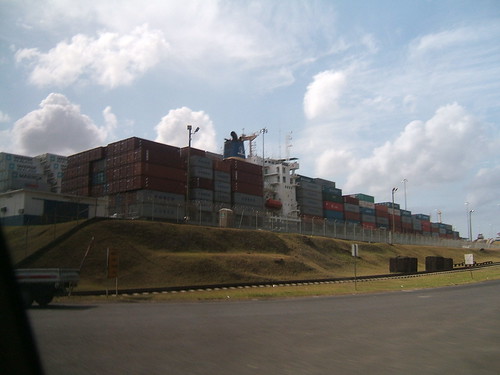
Container ship in Gatun Locks, Panama Canal
Suez Canal
I visited the lock-free Suez Canal in 2009, as described in the post Canal Zone, Egypt.

Maersk Line 'Sealand Slings' with deck container stacks 6-high in places heading north on the Suez Canal
Intermodal transport
Whilst massive container ships can economically move goods large distances, docking requires deepwater berths with specialist handling equipment so getting to the final destination usually requires transhipment to other transport modes - road, rail or sometimes smaller ships.
The significance of road trailers for motor trucks was mentioned in 'Background' above. Although local arrangements vary in different countries, articulated flatbed trucks for containers are a familiar sight. The Wikepedia article here gives a useful survey (and explains the various terms used to describe these vehicles).
But railways have been able to capture part of this market, moving containers between ports and inland distribution centres, from where final delivery may be by road. In the U.K. Freightliner offer over 37 direct routes between sea ports at Felixstowe, Southampton, Tilbury, London Gateway and Seaforth connected to 'major conurbations'.

Bournemouth by Train: View from Winchester platform 2, showing Up 'Freightliner' train passing.
At these terminals, rail-mounted goliath gantry cranes transfer containers to and from trains of special flat bogie wagons. The cranes are tailored to each site and many were constructed by famous bridge builders Sir William Arrol (who became Clarke Chapman in 1969). Freightliner describe the Seaforth (Liverpool) crane as follows:-
Terminal Crane Arrol 2-5-2 with with two cantilver outreaches built 1969. Specifically designed to load ISO containers on/off rail wagons stabled within the span of the crane and road wagons under one cantilver, the other cantilever used for the storage of containers. Rail span: 23.05m. S.W.L. under twistlocks: 32.0 tonnes. Lifting capacity: 20, 30, 40 and 45 foot containers at 13 lifts per hour.Lawley Street, Birmingham, is an example of an 'inland port' or distribution centre.

Part of Lawley Street container depot.
Where containers are to be on- and off-loaded at destinations with fewer facilities, smaller ships (frequently provided with cranes on the vessel) are used.

View from the bridge of 'RMS St. Helena' en route from Cape Town to St. Helena, showing containers. The white-painted containers are 'reefers'. Note the two container-handling cranes in the 'stowed' position.
In my travels, I've seen a number of sea ports around the world modernised for handling shipping containers and a selection is illustrated below.
Liverpool
Liverpool and its docks have always fascinated me and many of my posts with the label Merseyside talk about docks and shipping on the River Mersey. Formerly operated by The Mersey Docks and Harbour Board, the docks are now run by Peel Ports whose website on its Liverpool facilities is here (and contains lots of interesting information, including data sheets for all the ship handling tugs operating on the Mersey).
In 1971, Seaforth Dock at the northern end of Liverpool Docks opened, with its group of strange-looking container-handling cranes for loading and unloading specialist container ships. This rendered many of the older docks redundant.There's a Wikipedia article here and an interesting aerial photograph by 'fragglehunter' here
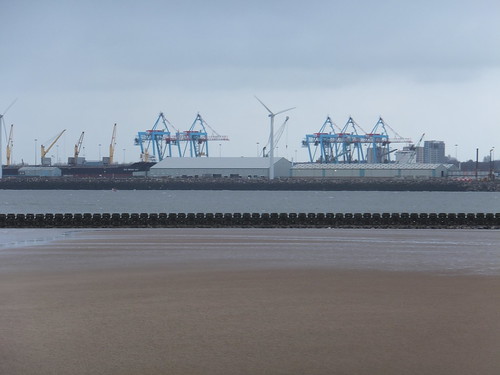 Royal Seaforth Dock seen from New Brighton.
Royal Seaforth Dock seen from New Brighton.
Peel Ports completed phase 1 of the new deepwater container port 'Liverpool2' in 2017, ultimately capable of handling two 380m-long 'Panamax New' vessels simultaneously - see the Wikipedia article here.

New Brighton by rail: View of Liverpool2 Dock from New Brighton, showing 4 of the 5 phase 1 container cranes with a group of young people in wet-suits on the beach.
There are two collections of my pictures showing Liverpool and Liverpool Docks
Southampton
I've visited Southampton a number of times over the years, but the pictures below are both taken from a train on a trip to Bournmouth in 2019 (described here. The Western Docks at Southampton now form a container port. The largest berth DP5, served by 5 container cranes, can accommodate 'Post-Panamax' vessels such as the 20,000 TEU 'MOL TRIUMPH' shown below.

Bournemouth by Train: View of DP World berth DP5 at Southampton after passing Millbrook station. The ship is MOL TRIUMPH.

Bournemouth by Train: View of DP World container cranes at berths DP1 to 4 at Southampton with Freightliner container crane in foreground. Note the 'Hoyer' tank container.
Yangon, Myanmar
In 2014, I walked along Strand Road, to see what was visible of the enclosed docks, as described here).
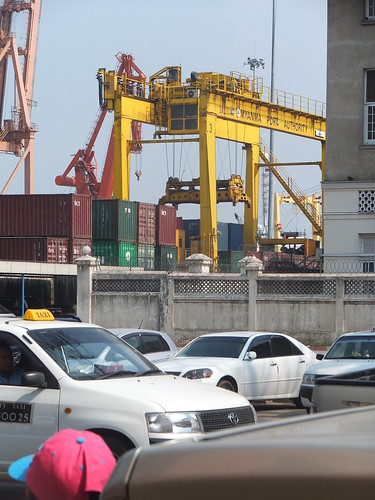
Yellow-painted Container Crane, showing the container-handling 'spreader' suspended from lifting cables, adjacent to Strand Road, Yangon, Myanmar.
Auckland, New Zealand
On the 'Tropic of Capricorn' trip early in 2020 (described here, I saw Auckland docks from both land and sea.
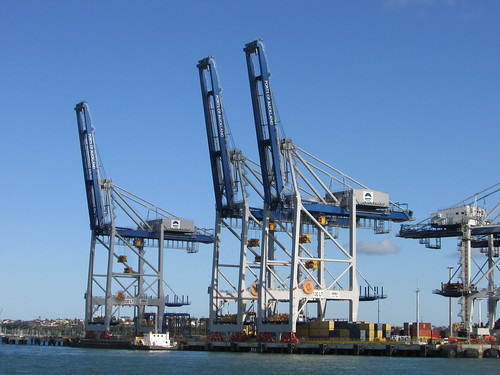
Container cranes on Fergusson Wharf, Auckland viewed from 'Caledonian Sky' (Tropic of Capricorn)
Haydarpasa (Istanbul), Turkey
Whilst exploring Istanbul's ferries in 2018 (described here, I saw the container port at Haydarpasa.
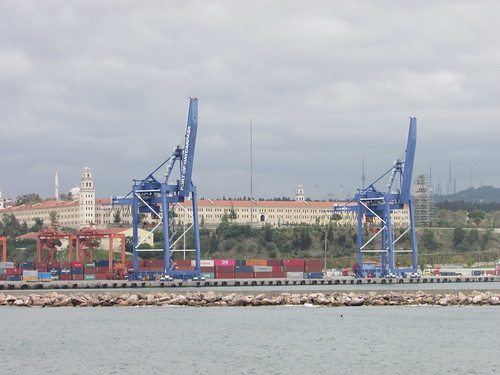
Port of Haydarpasa (Asian side) with two blue-painted container cranes and orange Straddle Cranes. In the background, the massive Selimiye Barracks (Istanbul's Ferries: Eminonu - Kadikoy).
Valparaiso, Chile
In 2016, a cruise to visit the Chilean fjords and the Antarctic Peninsula embarked from Valparaiso. The departure is described in the post 'Silver Explorer'

Container terminal, Valparaiso with Hapag-Lloyd container ship ‘Santa Teresa’.
Books
[1] 'Deep Sea and Foreign Going - Inside Shipping, the Invisible Industry that Brings You 90% of Everything' by Rose George, published by Portobello Books (ISBN: 078 1 84627 299 8).
[2] 'The Box: how the shipping container made the world smaller and the world economy bigger' by Marc Levinson, published by Princeton University Press (ISBN: 978-0-691-13640-0).
